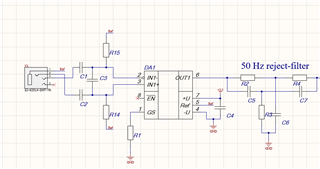Other Parts Discussed in Thread: TLV316, INA128
The sensor uses a unipolar power supply, but thanks to a high-pass filter, the signal is shifted to the midpoint (Ref = 3.3 V / 2 = 1.65 V). At the output of the amplifier, there is a notch filter with a frequency of 50 Hz. However, the output contains only noise with amplitudes up to mV. What could be the error in my design?


